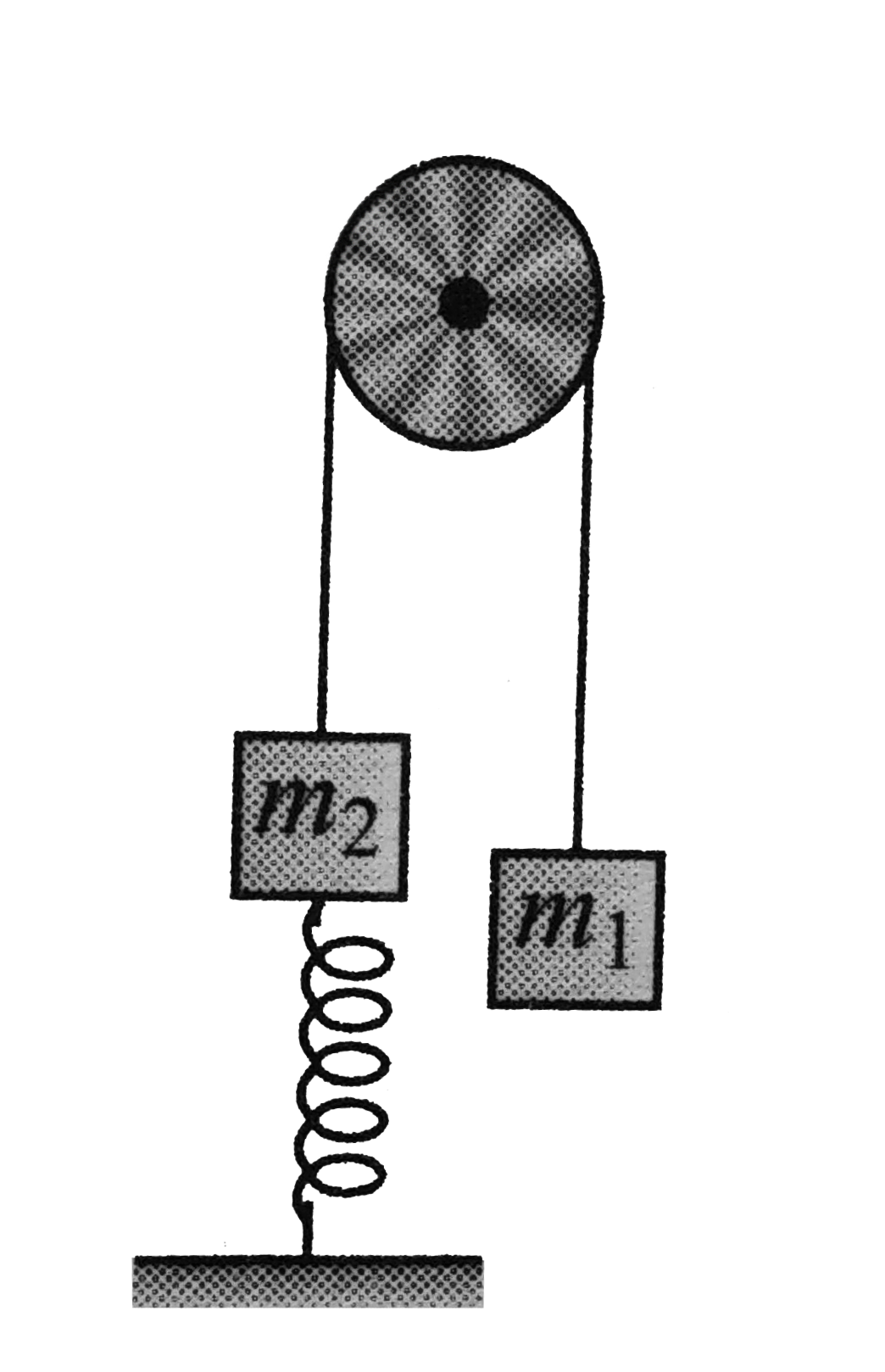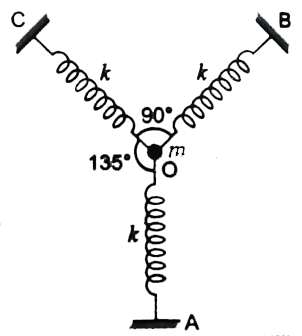When a particle of mass m is attached to a vertical spring of spring constant k and released, its motion is described by y(t)=y0sin2ωt, where 'y' is measured from the lower end of unstretched spring. Then ω is :
12√gy0
√gy0
√g2y0
√2gy0
To solve the problem, we need to analyze the motion of a mass attached to a vertical spring. The motion is described by the equation:
y(t)=y0sin2(ωt)
where y is measured from the lower end of the unstretched spring.
1. Understanding the Motion:
The given equation y(t)=y0sin2(ωt) indicates that the particle oscillates with a motion that is not simple harmonic because of the sine squared term. We can manipulate this equation to express it in a more recognizable form.
2. Using the Identity:
We can use the trigonometric identity for sine squared:
sin2(θ)=1−cos(2θ)2
Applying this to our equation:
y(t)=y0sin2(ωt)=y0⋅1−cos(2ωt)2=y02−y02cos(2ωt)
3. Identifying the Oscillation:
The equation can now be rewritten as:
y(t)−y02=−y02cos(2ωt)
This shows that the motion is oscillatory about the equilibrium position y=y02 with an amplitude of y02.
4. Finding the Angular Frequency:
The standard form of simple harmonic motion is:
x(t)=Acos(ω′t+ϕ)
Comparing this with our equation, we see that the angular frequency ω′ is 2ω.
5. Relating to Spring Constant:
For a mass-spring system, the angular frequency ω is given by:
ω=√km
Since we have 2ω from our oscillation, we can write:
2ω=√km
6. Finding the Spring Constant:
At equilibrium, the spring force equals the weight of the mass:
k⋅x=mg
where x is the extension from the natural length of the spring. In our case, the extension is y02:
k⋅y02=mg
Thus, we can express k as:
k=2mgy0
7. Substituting Back:
Now substituting k back into the equation for ω:
2ω=√2mg/y0m=√2gy0
Therefore,
ω=12√2gy0=√g2y0
Final Answer:
Thus, the value of ω is:
ω=√g2y0
The given equation y(t)=y0sin2(ωt) indicates that the particle oscillates with a motion that is not simple harmonic because of the sine squared term. We can manipulate this equation to express it in a more recognizable form.
We can use the trigonometric identity for sine squared:
sin2(θ)=1−cos(2θ)2
Applying this to our equation:
y(t)=y0sin2(ωt)=y0⋅1−cos(2ωt)2=y02−y02cos(2ωt)
The equation can now be rewritten as:
y(t)−y02=−y02cos(2ωt)
This shows that the motion is oscillatory about the equilibrium position y=y02 with an amplitude of y02.
The standard form of simple harmonic motion is:
x(t)=Acos(ω′t+ϕ)
Comparing this with our equation, we see that the angular frequency ω′ is 2ω.
For a mass-spring system, the angular frequency ω is given by:
ω=√km
Since we have 2ω from our oscillation, we can write:
2ω=√km
At equilibrium, the spring force equals the weight of the mass:
k⋅x=mg
where x is the extension from the natural length of the spring. In our case, the extension is y02:
k⋅y02=mg
Thus, we can express k as:
k=2mgy0
Now substituting k back into the equation for ω:
2ω=√2mg/y0m=√2gy0
Therefore,
ω=12√2gy0=√g2y0
Thus, the value of ω is:
ω=√g2y0
Topper's Solved these Questions
Similar Questions
A block of mass 'm' is attached to the light spring of force constant K and released when it is in its natural length. Find amplitude of subsequent oscillations.
View SolutionIn an ideal pulley particle system, mass m2 is connected with a vertical spring of stiffness k. If mass m2 is released from rest, when the spring is underformed, find the maximum compression of the spring.

View Solution
Knowledge Check
A particle of mass m is attached to three identical springs of spring constant k as shwon in figure. The time period of vertical oscillation of the particle is
 A2π√mkB2π√m2kC2π√m3kDπ√mk
A2π√mkB2π√m2kC2π√m3kDπ√mkA particle of mass m is attached to three identical massless springs of spring constant k as shown in the m 135 figure. The time period of vertical oscillation of the particle is
 A2π√mkB2π√m2kC2π√m3kDπ√mk
A2π√mkB2π√m2kC2π√m3kDπ√mkAn object of mass m, oscillating on the end of a spring with spring constant k has amplitude A. its maximum speed is
AA√k/mBA2k/mCA√m/kDAm/k

A ring of mass m is attached to a horizontal spring of spring constant k and natural length l0. The other end of the spring is fixed and the ring can slide on a horizontal rod as shown. Now the ring is shifted to position B and released Find the speed of the ring when the spring attains its natural length.
View SolutionA block of mass m hangs from a vertical spring of spring constant k. If it is displaced from its equilibrium position, find the time period of oscillations.
View SolutionA ball of mass m is attached to the lower end of a light vertical spring of force constant K. The upper end of the spring is fixed. The ball is released from rest with the spring at its normal ( unstretched ) length, and comed to rest again after descending through a distance x.
View SolutionA block of mass 'm' is attached to a spring in natural length of spring constant 'k'. The other end A of the spring is moved with a constat velocity v away from the block . Find the maximum extension in the spring.

View SolutionA particle of mass m is fixed to one end of a massless spring of spring constant k and natural length l0. The system is rotated about the other end of the spring with an angular velocity ω ub gravity-free space. The final length of spring is
View Solution
